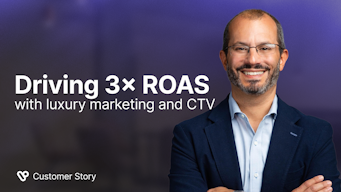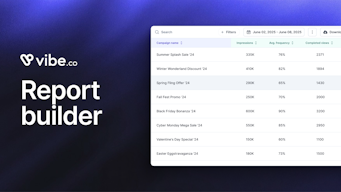What is Media Buying? Definition and Guide
What is media buying? A Marketer’s Guide
Building a successful marketing campaign and a strong connection with your audience requires more in the internet era than it ever did before. A memorable slogan and a relatable ad will no longer do the trick. This is where media buying comes in, as it allows you to broaden your online presence quickly and more effectively. What is media buying? How does it work? Here is all you need to know.
What is media buying?
The media buying process is one pillar of your paid marketing strategy, where it can help you gain exposure on a wide variety of media types. Effective media buying consists in identifying and purchasing the most relevant and well-timed ad space for a given audience at the most competitive price. Part of what makes this solution so efficient is that it applies to both digital channels (social media, websites, streaming), and more traditional digital media (radio, TV, print).
Talented media buyers know how to spend the least amount of money to achieve optimal exposure. From negotiating with the websites and other channels where your ads should appear to purchasing the right placement, at the right time, to monitoring your success by analyzing the metrics produced by your marketing performance tools, the role of the media buyer is central to a successful campaign.
What’s the difference between media buying and media planning?
Media planning and media buying should both be part of your marketing process, at least if you choose to rely on paid advertising. Without making the right upstream decisions and creating a sound media plan, media buying is a waste of resources.
MEDIA PLANNING
The media planning process is one of analysis and goal setting. It involves market research, defining a budget, understanding target audiences, preferred channels, and messaging style. The media planning team can then use this information to build a successful strategy that will drive your ROI.
MEDIA BUYING
The media buying process can only begin after a the creation of a sound media plan. It involves finding relevant placements and securing them through manual bidding, programmatic buying, or direct buying.
Manual bidding requires you to place and manage your bids through an ad platform. Programmatic media buying, on the other hand, relies on artificial intelligence and complex algorithms to place real-time bids on just the right ad space to match your target audience. For instance, if you are a car dealer, the platform will automatically place your ads on channels related to the automotive sector. Direct buys require the media buyer to negotiate with a specific advertiser to agree on preferred ad rates and run times. Using the same example, it would mean working straight with the administrators of car-related websites or magazines publishers.
Media Buying: how does it work?
In the digital world, automated media buying – or programmatic media buying – is ubiquitous. The negotiating process is not eliminated, but the purchase of impressions happens through open and private marketplaces. Although it doesn’t allow any true relationships to be formed with the publishers, it has the advantage of being much quicker.
The automated buying process involves three distinct components:
- DPS (Demand Side Platforms), which is where campaigns are set up by ad agencies and advertisers. DPS are also used for bidding, ad inventory, and performance-based optimization.
- SSP (Supply Side Platforms), which publishers use as a DSP to sell their ad inventory.
- The Ad Exchange Marketplace, which allows publishers and advertisers to use RTB (Real-Time Bidding) to buy and sell ad inventory.
Although RTB is a common way to purchase impressions, publishers also hold private auctions. Alternatively, the programmatic direct option takes bidding out of the equation and makes it possible to buy impressions at a fixed CPM (Cost per Thousand Impressions).
Ad networks (including such platforms as Google AdSense and Facebook Audience Network) allow advertisers to gain access to ad inventory from various publishers.
Digital media buying offers a cost-effective solution, freeing up some of the time that you would otherwise spend on negotiating to focus on ad performance instead.
What are the challenges of media buying?
The media buying space is not immune to the constant changes that affect the online world. A good example of the challenging media-buying landscape right now is Apple’s ATT (AppTrackingTransparency) rollout on iOS 14, which adds restrictions on cookies. This new feature requires iOS app users to be asked whether they agree to enable tracking when they open an app, and how to opt out if not, which many of them undoubtedly will. In terms of targeting and conversion tracking, the impact of such measures should not be underestimated.
Marketing measurement is another potential issue, and it is essential for media buyers to understand which campaigns are successful and why. It allows them to work toward optimizing budget allocation, yet companies have difficulty verifying that their campaigns are triggering sufficient conversion. Be sure to use the right tools or software to monitor your performance.
Ad fraud also continues to affect many organizations that don’t always have the means of identifying fraudulent sites. They get tricked into buying advertising space or charged for clicks/impressions from click farms or bots. The issue is especially common in programmatic advertising which, though it facilitates real-time ad placements, doesn’t guarantee adequate review of the sites offering ad space.
Optimizing your strategy mid-campaign could also prove complicated, as marketing results are typically available after the fact, only allowing you to assess its success in hindsight. This issue can be fixed by opting for a powerful marketing platform which will provide more instantaneous marketing performance insights.
Media Buys: our negotiation tips
Media buying, above all else, demands skillful negotiations to ensure that the ad spaces you purchase bring you the most value. Successful ad campaigns don’t happen in a vacuum, which means you will need to work with the right companies and develop reliable contracts through careful negotiation.
HAVE A CLEAR BUDGET
Before beginning any negotiation, you should know exactly how much you are willing to spend on premium ad placements. Based on this number, assess whether certain publications are worth spending more on so you can proceed by order of priority.
BE WELL INFORMED
Even outside of the media planning stages, you should seek to gather as much practical information as possible about the factors that can impact the success of your campaigns. Knowing how much leads typically cost in your industry, what the standard cost of an ad placement is on such or such type of website, or what types of ads perform the best on various media will prove incredibly useful.
CHOOSE THE RIGHT NEGOTIATION TACTICS
If you, your negotiation partner, or both are unwilling to compromise on your agreement, then zero-sum negotiations may be in order. Just keep in mind that this is not the right approach if you are hoping to establish a long-term relationship with the media company in question.
The alternative is integrative negotiations, where a compromise is found to ensure both parties get a reasonable deal.
The best media buying platforms
The best media buying platforms include:
- Google Display & Video 360, which belongs to the Google Marketing Platform and offers seamless integration with Google Analytics.
- The Trade Desk, which will give you access to premium publishers.
- Amazon DSP, which can reach users on Amazon-owned media.
- AdColony, which is a mobile-oriented media buying platform.
- AdCritter, which is targeted at small businesses.
- Vibe.co, which focuses exclusively on CTV media buying.
Measuring the success of a media buy
When it comes to buying media, there are a lot of different factors to consider in order to measure the success of the buy. The first step is to determine what you want to achieve with the campaign. Do you want to increase brand awareness, drive website traffic, or generate leads?
After you’ve determined your goal, you need to come up with measurable objectives that will indicate whether or not you’ve achieved your goal. For example, if you’re aiming to increase brand awareness, you might look at metrics like reach, impressions, or social media shares.
There are several ways to measure the success of a media buy, based on your objectives. The first way is to look at how much traffic the ad generated. One key element is the cost per thousand impressions (CPM). This is simply the cost of the ad divided by the number of impressions it received. You also need to look at click-through rate (CTR), which is the percentage of people who click on your ad after seeing it. You can use a tool like Google Analytics to see how many people clicked on the ad and then visited your website.
Another way to measure the success of a media buy is to look at how many leads or sales were generated as a result of the ad. You can track this using a tool like Salesforce or HubSpot. This will tell you how many leads or sales were generated as a result of the ad, and you can then calculate the cost per lead.
Additionally, you can look at the frequency: how often did they see/hear your ad? Or at the engagement: what kind of reaction did the ad generate?
Media buying best practices
Successful media buying requires a well-planned out strategy. Think about your goals in undertaking the ad campaign (driving more traffic, increasing brand awareness, etc.) and use KPIs to make sure your efforts align with your objectives.
Aiming your ad campaign at the wrong target audience will yield little to no results. Buying media of the right kind means your message will reach the ideal consumer. Learn to know and understand your audience (demographic, socio-economic status, preferred social media platforms, etc.) so you can advertise on the right channels.
A media buyer should be as involved in the campaign they are overseeing as possible. If using a DSP, you should define clear outlines for your campaign (budget, type, target audience, creative assets, bidding strategy, etc.). The more details you provide, the more accurate the results will be.
Finally, be sure to monitor your campaigns’ performance at every stage of its progress. If you only begin gathering data once you feel like some improvement is needed, you will lack precious information that you could have started collecting as soon as it launched. For example, if you notice that your video ad is performing much better than three static ads combined, then, as a media buyer, you can decide to use a larger proportion of the funds for video ads, thus maximizing your budget’s ad potential.
Media buying demands much consideration and some trial and error if you wish to achieve optimal results. This is why coupling a sound strategy with great platform that will help you keep track of your performance is key when it comes to meeting your marketing targets through effective ads.


